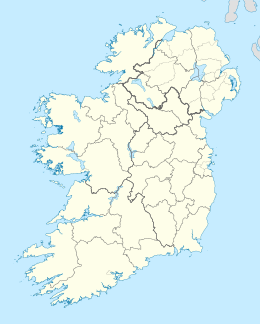Inishbofin, County Galway
| Native name: Inis Bó Finne | |
|---|---|
| Geography | |
| Location | Atlantic Ocean |
| Coordinates | 53°37′N 10°12′W / 53.617°N 10.200°WCoordinates: 53°37′N 10°12′W / 53.617°N 10.200°W |
| Area | 16.5 km2 (6.4 sq mi) |
| Length | 5.5 km (3.42 mi) |
| Width | 3 km (1.9 mi) |
| Highest elevation | 70 m (230 ft) |
| Highest point | Westquarter |
| Administration | |
| Province | Connacht |
| County | Galway |
| Demographics | |
| Population | 160 (2011) |
Inishbofin (derived from the Irish Inis Bó Finne meaning 'Island of the White Cow') is a small island off the coast of Connemara, County Galway, Ireland. Inishbofin has around 180 inhabitants and is a popular tourist destination.
The island's English name Inishbofin is derived from the Irish name Inis Bó Finne ('Island of the White Cow'). There are several legends concerning the origins of the island's name. According to one legend, the island was actually a floating place until some fishermen landed on it in a fog. By bringing fire onto the island, they dispelled the magic, fixing it in place. They then saw an old woman driving a white cow, which turned into a rock when the woman struck it with a stick.
The Irish name has also been anglicised as 'Innisboffin' and 'Boffin' or 'Bophin' island.
Inishbofin lies around 8 kilometers (5.0 mi) off the Connemara coast opposite of Ballinakill Harbour and Cleggan Bay. It is separated by a narrow channel from Inishark (Shark island). It is about 5.5 km (3.4 mi) long and 3 km (1.9 mi) wide. The highest point is in the Westquarter and rises to 292 feet (89 metres).
Much of the island is a Special Area of Conservation (due to the presence of corn crakes and seals). The island has no trees or forests whatsoever. Any wood was cut down and used as heating fuel. Because of the salt-enriched air, trees were never able to re-establish themselves.
It is not known when Inishbofin was first settled. There is no evidence of a Mesolithic, and only circumstancial evidence of a significant Neolithic presence. Although there are pre-historic field systems, their age has not been definitely established and could be anywhere between Bronze Age and early Medieval. Neolithic and Bronze Age monuments, found in significant numbers on the Connemara mainland, are conspicuous by their absence. Definite traces of human settlement are available only from the Iron Age onwards, such as the remains of promontory ring forts like 'Dun Mor'.
...
Wikipedia

